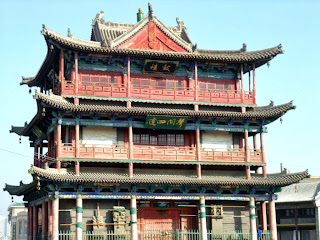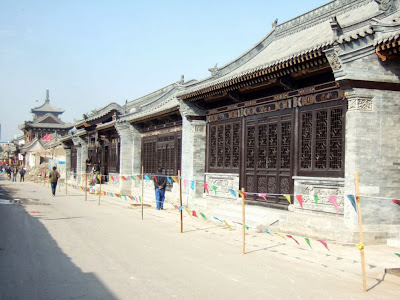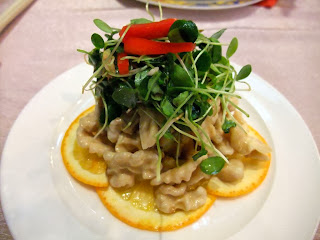

The ancient city Datong (大同古城), bordered to Inner Mongolia to the north and west, located near The Mongolia Great Wall Pass, was known as Pingchen (平城) in the olden days. Being at least 2400 years in history, Datong City is one of the 24 famous historical and cultural cities in China. In the past it was a political, economic and military center of ancient North China, attracting people for trades from many nations. In the present it is a prefecture level city of Northern Shanxi, nicknamed as City of Coal (煤都). Extensive development in the coal mining and related sectors get it the title as China's most polluted City but in the meantime, large reserve of the commodity also turns it into an important energy base in the nation.



The three storey high Datong Drum Tower standing at southern end of the city, was built in Ming Dynasty and restored in Qing Dynasty, for the purpose of announcing the hours at night. There were 4 at four corners of the city originally including a bell tower, but Drum Tower was the only one left. During the repair works in year 1978, its central tunnel that allowed vehicles to cut through was sealed up and closed and new roads were replaced at the surroundings to enabling the traffic to smoothly pass around it. Lately the structure was further adorned in color painting and the original complimentary phrases from the reputable noble people or ancient scholars were again framed up and hanged at its four directions. Among them there was a philosophy phrase written by Emperor Kangxi (1654-1722), engraved at the north pillars. It says "Reserve 30% in all affairs to broaden the view of the sky and earth, keep little space at heart for the generations to cultivate (世事留三分,天宽地阔 ; 心田留一点,子耘孙耕)。 Drum Tower is a great example of the Ming and Qing architectural structure.


Datong had its peak blossom period during 5th-6th century when it was a national capital of Northern Wei (386-534) for 96 years. It was also a supportive capital for Dynasty Liao (916-1125) and Jin (1115-1234), and an important defensing and trade center during Ming (1368-1644) and Qing Dynasty (1644-1911). The glorious period of the past left behind the city with series of splendid historic and cultural relics like Temple Huayan-si, Shanhua-si, Hanging Temples, Yungang Grotto etc.



Brief History of Datong: Commencing from as early as Stone Age, human had lived around Datong area and began to form their own ancient living culture by using simple stone equipments. Residents were started founded at the site during the early age of Dynasty Xia and Shuang (夏商 2070-1046 BC). Coming to Spring and Autumn period (770-476BC), it was occupied by northern minority tribes and during Warring era (476-221BC),the place had become an important defensing bordering city of Zhou State. The defensing position was further strengthened with building of Great Wall against the northern tribes Xiongnu, by Emperor Qing-Shihuang after he unified the country in 221 BC. But 12 years later in 209BC the city fell into the hand of Xiongnu. The territory was soon invaded by Han ethnic lead by Liu Pang, the founder of Han Dynasty (206BC-220 AD). The well known battle in Chinese history happened here was the Battle of Baideng (白登之围) where Liu-Pang was trapped by Xiongnu for 7 days and nights. He lose in the battle but rescued. Liu-Pang later compromised with Xiongnu and had peace settlement with Xiongnu through intermarriage. Xiongnu was at last defeated by Emperor Han-Wudi (141-87BC).


Taoist Temple Cunyang-Gong (纯阳宫), originally named as Lvzu-Miao (吕祖庙) is also a major historical and cultural site protected by Datong Municipal. The site was built with three courtyards in a solemn manner combined with ingeniously built in landscapes in the style of Suzhou gardens.


Many old buildings on the west Drum Tower Street were demolished when the reconstruction work of the 14th century Ming built defensive wall began two years ago (2010). Every corner of the city was full of wreckage as if debris caused by earthquake or war bombings.



The replica of Ming-Qing new buildings though looks elegant but we like old ones more.


Restaurant Fenglin-Ge (风临阁)is one of the focus spots for many elderly Chinese as it was related to a romance of a King and a Beauty, happened in Ming Dynasty. The legend about the love affair between Ming Emperor Zhen-de (朱正德 1506-1521) and a village girl was filmed into movie in 1960s under the name as The Kingdom and the Beauty (江山美人) making its actress Lindai won the title of best actress in Hongkong Movie Festival. Emperor Zhu-Zhende when ruling the country, used to be in disguise as a commoner and traveled around the nation. There was once he arrived at a small town called Longfeng-zhen and met a pretty young village girl called Lifeng. He fell in love with her at first sight. Lifeng was staying with his brother and they ran a Tea-house at town. The Emperor had one night stayed with Lifeng without letting her know who he was. The identity was exposed the next morning when he was escorted back by the royal guides. The Emperor promised and ensured Lifeng that he would make her his princess. Lifeng waited and waited, days after days, but received no news from him. Her heart broken with shame and deep depression especially when she found herself pregnant. Being an unmarried girl conceived with a baby, she was further hit hard by those ridiculed gossiping which made her suffering so much that she finally collapsed and fell seriously sick. The Tea-house attendant Ah-niu when watching the girl whom he liked so much since young, was going to torture to death, decided to travel to the capital city alone to bring the news to the Emperor. He overcame layers and layers of obstacles and difficulties to finally let the Emperor aware of his promise made to Lifeng. Unfortunately, by the time Lifeng was bestowed as a princess and grandly greeted into the palace, she died. It was indeed quite a sad story. The Fenglin-Ge at Datong was said to be the old site of Longfeng Tea-house.



In regardless of its legendary love story, Fenglin-ge is quite a reputable restaurant for its fine cuisine in the city of Datong.



A Statue of Longfeng-zhen beauty Lifeng was erected at the door entrance of the restaurant.



Restaurant Fenglin-Ge at night.


Stepping into the restaurant, attention was immediately caught by this huge screen piece of work that was dramatically engraved with ancient city of Datong.


An imperial way of decorations with wall, beams, pillars and ceiling gilded in gold, make Fenglin-Ge easily mistaken as a royal dining hall. The set up looks noble, grand and awesome!



An Emperor's romance had made Longfeng Tea-house in fame for 600 years and the fine cuisine and royal styled environment gain Fenglin-ge a good reputation in dining servicing lines. Dishes that stimulated our taste bud includes their Dim-sam and some cold dishes like cloud-ear fungus, steam eggplant. Some non-tradition dish like pork belly with dried wild vegetable was also very well prepared and cooked.



Its lion head meat ball soup and black sesame congee desert looks good and taste well.


Datong City is an eating heaven. Seared meat with fresh fungus (过油肉) is one of the local delicacy and almost all restaurants sell the dish. Gongpo Chicken is a common dish in China but in Datong, it was extremely well cooked and delicious. I especialy love its walnut dish and its presentation.



A 4-stars hotel provides a 5-stars dining place and cuisine. The more simple the dish is, the harder to cook. We really enjoyed the way the chef cooked the Napas (long cabbage)and Choysam (local green).



Various buns were supplied for our buffet breakfast.


The beautiful deserts, some appetizers and local snacks.



Enjoy a luxurious breakfast at Garden hotel in Datong City


Salad sauces at Western food corner.


Noodle daoxiao-mian (刀削面) is the most famous delicacy in Datong and it is well deserved for its reputation. The taste of the noodles varies from its varieties of condiments and ingredients relish that added to it.



The interesting Daoxiao-mian chef in action! Sharp and accurate in judgement for the size, the thickness, she flies the perfect trimmed noodles into the boiling pot in an incredible speed.



A bowl of daoxiao mian and a cup of black rice mixed porridge were our favorite breakfast every morning in Datong.



Garden Hotel at Datong is a 4-stars hotel with rooms surrounded a central courtyard. It provides comfortable accommodation with supplies of high standard breakfast, lunch and dinner at its restaurant. The jade carving luxurious junk is one of the decorative item at the restaurant door front.


Guests were brightened up with these two pots of blossom orchid flowers displayed at waiting lounge of Garden Hotel.


Dacheng-Fang (大成坊) at south east corner of Datong City is the ancestral temple for Confucius. It was restored into large building complex in early Ming Dynasty (1368-1644) by Yun-Zhongyi (云中驛) at the site to become a center of highest education and a place to worship Confucius. By end 20th century when there were only 5 or 6 structures left over, the place turned into a site for a secondary school but soon moved out as in year 2008, state government decided to restore and renovate the temple to make it recovery to its original. Two Arch gates were built along the 200 meter long Yunlu ancient cultural Street (云路古文化街) at the site. In olden days, Yunlu symbolized a smooth way for success for those students who had gained great achievement in imperial examination.



A glimpse of modern Datong!



Huairen county 怀仁镇 is a fast growing spot near Datong City especially its agriculture and farming development, and a prosperous town that travelers have to pass through when going or coming back from Yanmen Pass (雁门关), which was an important place in the defensing history of Chinese against the north nomadic tribes.


We were greatly surprised by the long distance services of Datong especially its luxurious coach service which was entirely out of our expectation. Chargeable at only about US$20 from Datong to Taiyuan, the double Decker provides you a comfortably reclining seat, arranged only 3 in a row (2+1), spacious and relaxing. Most satisfied was the bus used high way through out the journey allowing passengers to stop at modern rest place for clean wash room and have snacks.



Located in a basin at an elevation of 1040 meter, Datong does not have much vegetation or greens, but its natural beauty is breath taking.





No comments:
Post a Comment